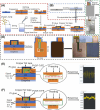Sensors Innovations for Smart Lithium-Based Batteries: Advancements, Opportunities, and Potential Challenges
- PMID: 40423816
- PMCID: PMC12116415
- DOI: 10.1007/s40820-025-01786-1
Sensors Innovations for Smart Lithium-Based Batteries: Advancements, Opportunities, and Potential Challenges
Abstract
Lithium-based batteries (LiBs) are integral components in operating electric vehicles to renewable energy systems and portable electronic devices, thanks to their unparalleled energy density, minimal self-discharge rates, and favorable cycle life. However, the inherent safety risks and performance degradation of LiB over time impose continuous monitoring facilitated by sophisticated battery management systems (BMS). This review comprehensively analyzes the current state of sensor technologies for smart LiBs, focusing on their advancements, opportunities, and potential challenges. Sensors are classified into two primary groups based on their application: safety monitoring and performance optimization. Safety monitoring sensors, including temperature, pressure, strain, gas, acoustic, and magnetic sensors, focus on detecting conditions that could lead to hazardous situations. Performance optimization sensors, such as optical-based and electrochemical-based, monitor factors such as state of charge and state of health, emphasizing operational efficiency and lifespan. The review also highlights the importance of integrating these sensors with advanced algorithms and control approaches to optimize charging and discharge cycles. Potential advancements driven by nanotechnology, wireless sensor networks, miniaturization, and machine learning algorithms are also discussed. However, challenges related to sensor miniaturization, power consumption, cost efficiency, and compatibility with existing BMS need to be addressed to fully realize the potential of LiB sensor technologies. This comprehensive review provides valuable insights into the current landscape and future directions of sensor innovations in smart LiBs, guiding further research and development efforts to enhance battery performance, reliability, and safety. Integration of advanced sensor technologies for smart LiBs: integrating non-optical multi-parameter, optical-based, and electrochemical sensors within the BMS to achieve higher safety, improved efficiency, early warning mechanisms, and TR prevention. Potential advancements are driven by nanotechnology, wireless sensor networks, miniaturization, and advanced algorithms, addressing key challenges to enhance battery performance and reliability.
Keywords: Battery management systems; Lithium-based batteries; Sensors; State of charge; State of health; Thermal runaway.
© 2025. The Author(s).
Conflict of interest statement
Declarations. Conflict of interest: The authors declare no interest conflict. They have no known competing financial interests or personal relationships that could have appeared to influence the work reported in this paper.
Figures
















Similar articles
-
Recent Advancements in Wearable Hydration-Monitoring Technologies: Scoping Review of Sensors, Trends, and Future Directions.JMIR Mhealth Uhealth. 2025 Jun 13;13:e60569. doi: 10.2196/60569. JMIR Mhealth Uhealth. 2025. PMID: 40513095 Free PMC article.
-
Management of urinary stones by experts in stone disease (ESD 2025).Arch Ital Urol Androl. 2025 Jun 30;97(2):14085. doi: 10.4081/aiua.2025.14085. Epub 2025 Jun 30. Arch Ital Urol Androl. 2025. PMID: 40583613 Review.
-
Wood Waste Valorization and Classification Approaches: A systematic review.Open Res Eur. 2025 May 6;5:5. doi: 10.12688/openreseurope.18862.2. eCollection 2025. Open Res Eur. 2025. PMID: 40438563 Free PMC article.
-
Continuous glucose monitoring in type 2 diabetes: a systematic review of barriers and opportunities for care improvement.Int J Qual Health Care. 2025 Jul 4;37(3):mzaf046. doi: 10.1093/intqhc/mzaf046. Int J Qual Health Care. 2025. PMID: 40338639 Free PMC article.
-
A Narrative review of advancements in knee Arthroplasty: Analyzing diverse prosthetic materials and their implications.J Clin Orthop Trauma. 2025 Apr 24;66:103034. doi: 10.1016/j.jcot.2025.103034. eCollection 2025 Jul. J Clin Orthop Trauma. 2025. PMID: 40433656 Review.
References
-
- A. Jinasena, L. Spitthoff, M.S. Wahl, J.J. Lamb, P.R. Shearing et al., Online internal temperature sensors in lithium-ion batteries: state-of-the-art and future trends. Front. Chem. Eng. 4, 804704 (2022). 10.3389/fceng.2022.804704
-
- J. Xiao, F. Shi, T. Glossmann, C. Burnett, Z. Liu, From laboratory innovations to materials manufacturing for lithium-based batteries. Nat. Energy 8(4), 329–339 (2023). 10.1038/s41560-023-01221-y
-
- X.-B. Cheng, C.-Z. Zhao, Y.-X. Yao, H. Liu, Q. Zhang, Recent advances in energy chemistry between solid-state electrolyte and safe lithium-metal anodes. Chem 5(1), 74–96 (2019). 10.1016/j.chempr.2018.12.002
-
- P.K. Kausthubharam, S. Koorata, Panchal, Thermal management of large-sized LiFePO4 pouch cell using simplified mini-channel cold plates. Appl. Therm. Eng. 234, 121286 (2023). 10.1016/j.applthermaleng.2023.121286
Publication types
LinkOut - more resources
Full Text Sources
